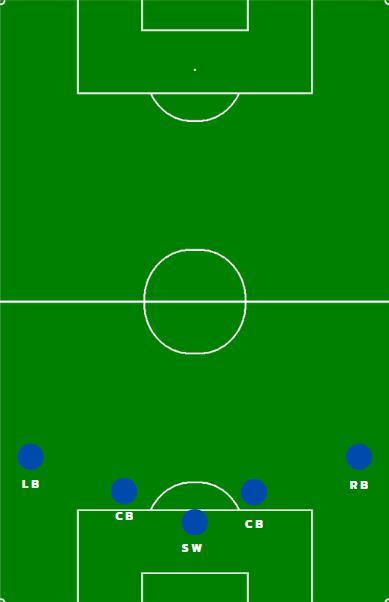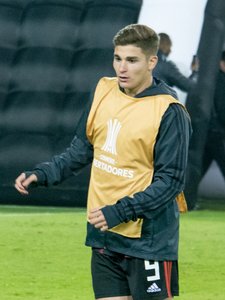In football, a team has 11 football players, one goalkeeper and 10 other players, consisting of defenders (defenders), midfield (midfielders) and attackers (Forward). depending on the map system used Those positions will also indicate the role and playing area of that position as well.
At first there were only forwards, half-backs and thrice quarterbacks. (three-quarter-backs), the first period named like this because It was during the 19th century that the 2–3–5 system was widely popular. The defense will have full-backs known as left-back and right-back. The midfield has left-half (left-half), center-half. (centre-half) and right-half (right-half) and in the offensive line is an outside-left. (outside-left), inside-left, center striker center-forward, inside-right and outside-right (outside-right) After that, the style of the system evolved to have many titles. For example, in the early 1970s, the term "half-back" was replaced by the term "midfielder", referring to the position played in midfield both in the middle of the field and on the flanks. The central midfielder has further evolved into an attacking midfielder and a defensive midfielder.
in modern games Positions in football are strictly defined like rugby or American football. Even so, most players tend to play in the same position throughout their careers. Because each position uses different skills and physical abilities. But there are some footballers who can play in multiple positions. which is called "Useful player" Today will talk about the details about the defender in the position of football.
Defender
In the sport of association football, a defender is an outfield position whose primary role is to stop attacks during the game and prevent the opposition from scoring.
Centre-backs are usually positioned in pairs, with one full-back on either side to their left and right, but can be played in threes with or without full-backs.
Defenders fall into four main categories: centre-back, sweeper, full-back, and wing-back. The centre-back and full-back positions are essential in most modern formations. The sweeper and wing-back roles are more specialised for certain formations dependent on the manager's style of play and tactics. Centre-backs are usually tall and positioned for their ability to win duels in the air.

Centre-back
The principal role of the centre-back, (or central defender) (historically called a centre-half) is to block the opponent's players from scoring, and safely clearing the ball from the defensive half's penalty area. As their name suggests, they play in a central position. Most teams employ two centre-backs, stationed in front of the goalkeeper. There are two main defensive strategies used by centre-backs: the zonal defence, where each centre-back covers a specific area of the pitch, and man-to-man marking, where each centre-back has the job of covering a particular opposition player.
Centre-backs are often tall, strong and have good jumping, heading and tackling ability. Successful centre-backs also need to be able to concentrate, read the game well, and be brave and decisive in making last-ditch tackles on attacking players who might otherwise be through on goal. Sometimes, particularly in lower leagues, centre-backs concentrate less on ball control and passing, preferring simply to clear the ball in a "safety-first" fashion. However, there is a long tradition of centre-backs having more than just rudimentary footballing skill, enabling a more possession-oriented playing style.
Centre-backs will usually go forward for set piece corners and free-kicks, where their height and jumping ability give them an aerial goal threat, while defensive duties are covered by the full-backs. Once the set piece is complete, they will retreat to their own half.
The position is sometimes referred to as "centre-half". This originates the late part of the 19th century, when most teams employed the 2–3–5 formation, the row of three players were called half-backs. As formations evolved, the central player in this trio (the centre-half), moved into a more defensive position on the field, taking the name of the position with them.
Sweeper
The sweeper (or libero (Italian: free)) is a more versatile type of centre-back that, as the name suggests, "sweeps up" the ball if the opponent manages to breach the defensive line.Their position is rather more fluid than other defenders who mark their designated opponents. The sweeper's ability to read the game is even more vital than for a centre-back.The catenaccio system of play, used in Italian football in the 1960s, notably employed a defensive libero. With the advent of the modern offside rule came the need to hold more of a defensive line to catch opposing players offside. Use of a sweeper role became less popular as the last man can play an attacking opponent onside, which could in the case of the sweeper be behind the main defence.
Former German captain Franz Beckenbauer is commonly seen as the inventor of the libero and the best player in the role. However, players such as Velibor Vasović and Armando Picchi were prominent sweepers prior to Beckenbauer. Some of the greatest sweepers were Gaetano Scirea, Bobby Moore, Franco Baresi, Daniel Passarella and Lothar Matthäus.
Full-back
The left-back and the right-back (generally referred to as the full-backs) are the defenders stationed at either side of the centre-backs to provide protection from attacking wide players. They often have to defend against the opponent's wingers, who will try to take the ball past them down the flanks in order to cross or pass into the penalty area to their attackers. Full-backs traditionally do not go up to support the attack but may move up as far as the halfway line depending on the defensive line being held. In the modern game, there has been the tendency to prefer the use of the attacking full-back (wing-back) role though they are more often than not still referred to as right- or left-backs.
Originally, a full-back was the last line of defence, but as the game developed in the early 20th century, the centre-half role was dropped backwards and came to be known as 'centre-back', and the full-backs were then pushed out wider to create the right-back and left-back positions.Due to the physical and technical demands of their playing position, successful full-backs need a wide range of attributes, which make them suited for adaptation to other roles on the pitch. Many of the game's utility players, who can play in multiple positions on the pitch, are natural full-backs. A rather prominent example is the PSG full-back Sergio Ramos, who has played on the flanks as a full-back and in central defence throughout his career. In the modern game, full-backs often chip in a fair share of assists with their runs down the flank when the team is on a counter-attack. The more common attributes of full-backs
Wing-back
The wing-backs (or attacking full-backs) are defenders with a more advanced emphasis on attack. The name is a portmanteau of "winger" and "full-back", indicating greater emphasis on their responsibilities in attack. They are usually employed as part of a 3–5–2 formation, and can therefore be considered part of the midfield when a team is attacking. They may also be used in a 5–3–2 formation and therefore have a more defensive role. The term "wing-back" itself is gradually falling out of use as there is less of a distinction with the full-back roles in the modern game, especially when used in a 4–3–3 or 4–2–3–1 formation.
The wing-back role is one of the most physically demanding positions in modern football. Wing-backs are often more adventurous than traditional full-backs and are expected to provide width, especially in teams without wingers. A wing-back needs to be of exceptional stamina, be able to provide crosses upfield and then defend effectively against an opponent's attack down the flanks. A defensive midfielder is usually fielded to cover the advances of an opponent's wing-back.
Wing-backs are often more adventurous than full-backs and are expected to provide width, especially in teams without wingers. A wing-back needs to be of exceptional stamina, be able to provide crosses upfield and defend effectively against opponents' attacks down the flanks. A defensive midfielder may be fielded to cover the advances of wing-backs.[61] It can also be occupied by wingers and side midfielders in a three centre-back formation, as seen by ex-Chelsea and ex-Inter Milan, and current Tottenham Hotspur manager Antonio Conte.
Examples of players who could and did play as wing-backs were AC Milan teammates Cafu and Serginho, Barcelona player Dani Alves, Roberto Carlos of Real Madrid's Galácticos era, former River Plate's defender Juan Pablo Sorín, World Cup winning German Andreas Brehme, Parma's legend Antonio Benarrivo, Angelo Di Livio of Juventus and Italy and former Corinthians, Arsenal and Barcelona star Sylvinho.
It can be concluded that to know that in football there must be 11 players, with the positions of all 11 football players consisting of Goalkeeper, defenders, Midfielderl and forwards, what roles these positions play and how they play an important role in the team. playing of football with a code that forms a plan and determines how many players should have per position except the goalkeeper who has only 1 person I hope that the articles that have been written will be knowledgeable for those who are interested in football and different rules. If you want to find more information, you can find it in Google Chrome and Internet Explorer.
Reference
Defender (association football).the details of positions defender in football. [Online].Accessible https://en.wikipedia.org/wiki/Defender_(association_football)
Association football positions.the details of positions defender in football. [Online].Accessible https://en.wikipedia.org/wiki/Defender_(association_football)
Centre-back.the details of positions defender in football. [Online].Accessible https://en.wikipedia.org/wiki/Association_football_positions







